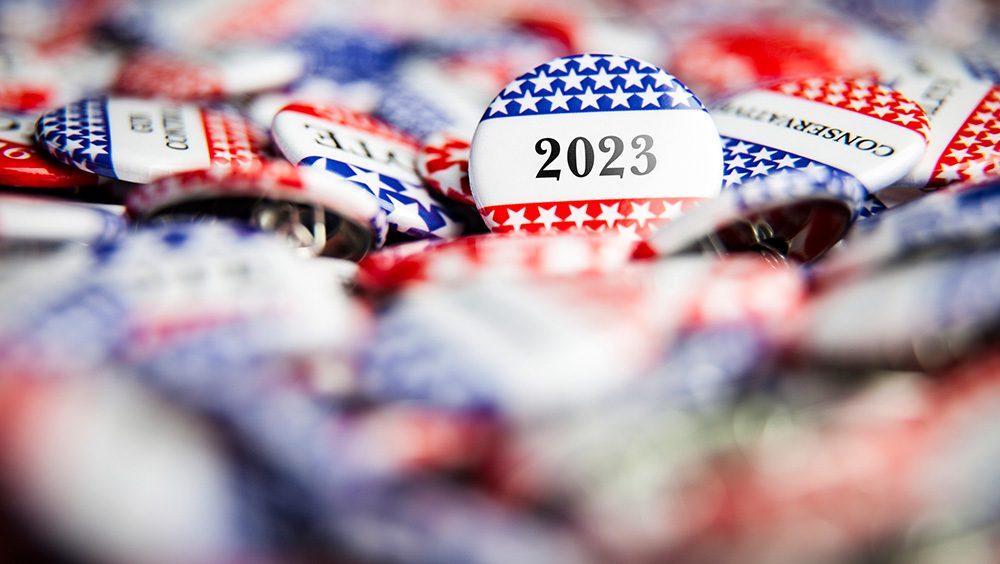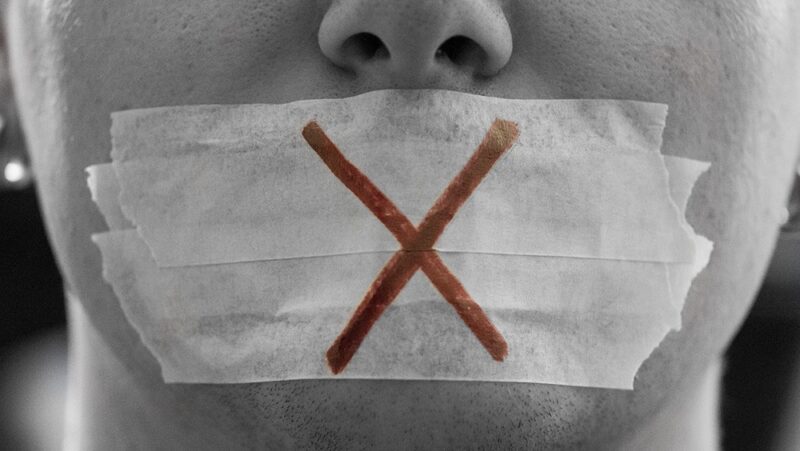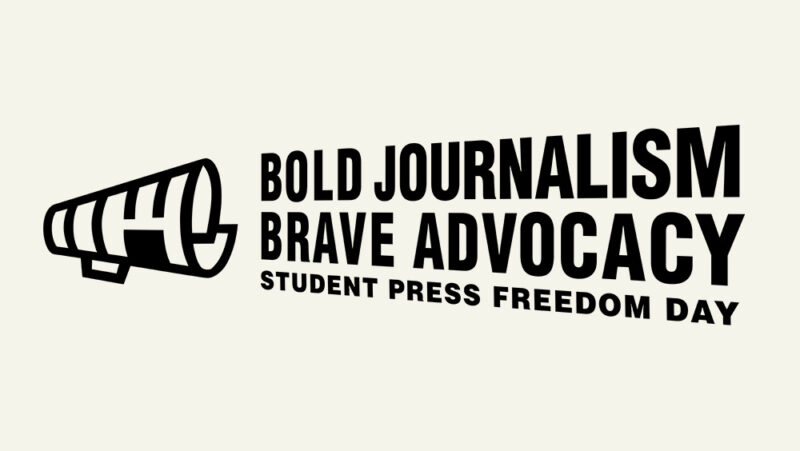First Amendment Stories of 2023: A Year in Review

The First Amendment is in the news all around us, from gag orders to prayer in schools to how speech is treated on the social media platforms so many people use every day.
As 2023 ends, here are five themes and related First Amendment stories that were prominent in the news – and in all our lives – this year.
Discover the top First Amendment stories of 2023
People learn about court gag orders and the First Amendment thanks to a high-profile defendant
Merriam-Webster’s annual word of the year for 2023 is not gag order, (it’s authentic). But judging by the spike in internet searches for “gag order” in 2023, the term is very much of interest. Gag orders in legal cases aren’t new, but due to the connection to former President Donald J. Trump, people were interested in how gag orders restrict a person’s right to free speech under the First Amendment.
RELATED: What is a gag order?
As Freedom Forum’s Gene Policinski wrote, “Such orders should be of concern anytime they are issued. The public and defendants have a First Amendment right and need to publicly review, critique and comment on the performance of the judicial system. This holds courts accountable and sustains public support for their operations. But that right may run up against the Sixth Amendment right guaranteeing a fair trial.”
Trump Gag Orders
Trump is facing charges in multiple cases. Two of those cases involve gag orders: the New York state civil fraud trial and the federal criminal case involving the January 6 riot at the U.S. Capitol. Trump and his legal team have disputed the gag orders in both cases.
Idaho Murders and Cameras
In Idaho, defendant Bryan Kohberger is facing a possible death sentence in an upcoming trial for the murder of four University of Idaho students in November 2022. The case has attracted widespread media attention and spun off many TV news specials and true crime podcasts. Because of the attention and possibility of it affecting the jury pool, the judge in the case issued a gag order preventing people involved in the case from speaking with the media. A coalition of news media appealed, but the judge maintained the order with a narrower focus. The judge has also banned TV news cameras from the courtroom, saying they jeopardize the defendant’s right to a fair trial, according to the Associated Press. The judge said the eventual trial would be streamed on the court’s YouTube channel.
Religion in public schools is not so easily dismissed as “separation of church and state”
Religion and government, especially public schools, is debated a lot. The phrase “separation of church and state” does not appear in the U.S. Constitution. Students are legally allowed to pray in public schools (with some restrictions). But there are limits on what government can and cannot do regarding religion in public schools.
Several court cases and First Amendment stories in 2023 underlined the push-and-pull of how religion intersects and interacts with public schools.
Praying Football Coach
Can a public school teacher pray during class and have students join in? That is very likely a no under the First Amendment. But there are other gray areas, such as a coach of a public high school football team praying on the field after a game. That was the question before the Supreme Court. They ruled in favor of assistant football coach Joseph Kennedy, who had been fired by the school district in Bremerton, Washington, for praying with students before and after football games. The court said the First Amendment protected the coach’s personal religious beliefs and that students could voluntarily join him in prayer. Kennedy got his job back in 2023 after the court ruled in his favor, but he quit after one game.
"I'm done."
— Freedom Forum (@1stForAll) September 20, 2023
High school football coach Joe Kennedy, whose case over his prayers on the field after games went all the way to the Supreme Court, resigned from the job the court had reinstated. https://t.co/hnHeNudXsa
RELATED: A First Amendment analysis of the praying football coach case
Church-run Public Charter School
The government, not churches or private entities, runs public schools. For charter schools, which operate with public funds but outside the traditional structure of school districts with elected boards, the lines between public and private aren’t so obvious. This year Oklahoma became the first state to authorize a charter school using public taxpayer funds but run by a private religious group. In this case, the Catholic Church would operate the St. Isidore of Seville Catholic Virtual School. Groups opposed to the school, including the American Civil Liberties Union, Freedom From Religion Foundation and Americans United for Separation of Church and State, have sued to block it. It's possible this case will go to the Supreme Court.
Religious Tradition and Hair
Public schools can enforce dress codes and impose other restrictions on how students present themselves. But those generally can’t interfere with a student’s private religious beliefs, like wearing a necklace with a religious symbol. But what about hair as a religious symbol? A Kansas school district faced calls of religious discrimination against an 8-year-old Native American student for requiring him to cut his hair. The student’s family and the ACLU said his braids were part of his cultural and faith tradition. The district’s policy requires boys to keep their hair to a certain length, with no ponytails allowed. There is no such policy for girls.
Threats to a free press include physical harm, police raids and AI
In the United States, incidents involving threats to journalists’ safety have dropped off since a massive spike in 2020 when many journalists were hurt and/or detained covering racial justice protests and the presidential election. The U.S. Press Freedom Tracker catalogues threats against journalists.
“The utility of the tracker grows every year,” Kirstin McCudden, of the Freedom of the Press Foundation, told Freedom Forum, citing how it reflects the state of U.S. press freedom every year.
Worldwide, journalists faced physical threats and death covering conflict. And in the U.S., they faced threats to press freedom, credibility and their own job security this year.
Kansas Newspaper Raid
The Marion County Record, a newspaper in Kansas, was raided by a local police department. The police also raided the home of the newspaper’s publisher and his 98-year-old mother, who died the next day. The police chief in the town of 1,900 who instigated the raid resigned under public scrutiny. Before the raid, the newspaper was looking into the employment record of the chief after he left the force in Kansas City, Missouri. As the Kansas Reflector reported in October about former police Chief Gideon Cody: “According to Record reporting, Cody left Kansas City under the threat of demotion, following accusations of creating a hostile work environment.” A reporter who was targeted in the raid quit her job, saying she “no longer felt comfortable in the Marion community.” The incident raised serious press freedom questions. The local prosecutor dropped all charges. The raid sparked a vocal push-back by national journalism and First Amendment advocacy groups.
When are police allowed to raid newsrooms? When does the First Amendment protect journalists? What happened at the Marion County Record?
— Freedom Forum (@1stForAll) August 19, 2023
We answer all of those questions. https://t.co/qrFB8TuMpR
RELATED: Why the Marion County newspaper raid should concern us all
AI in Journalism
The Hollywood writers and actors strikes this year involved one major point about entertainment workers’ job security: artificial intelligence. Less covered but similarly disruptive to the media industry is how AI will affect journalists’ jobs. The rollout and fast adoption of ChatGPT this year accelerated the conversation. The question came into better focus this year: How much will AI affect journalists’ jobs and damage credibility and trust? USA TODAY and its parent company Gannett faced questions about how it was using AI-generated content under fake bylines of made-up writers for its product review site. Gannett denied the allegations. In November, news and technology outlet Futurism reported that Sports Illustrated and its hedge fund ownership group published articles by fake AI-generated writers with fake headshot photos. The ownership group denied the allegations, claiming writers used “a pen or pseudo name.”
Following a long tradition, we can expect any number of attempts to regulate this new media, which are likely to result in First Amendment-based legal challenges. Legal scholars are already discussing whether AI merits any First Amendment protection at all.
Danger in War Reporting
This year was difficult for journalists’ safety worldwide, particularly in the Israel-Hamas and Ukraine-Russia wars. In early December, the Committee to Protect Journalists recorded 61 journalists and media workers killed covering the Israel-Hamas war since it began in October. CPJ’s database of media work deaths shows 17 journalists have been killed covering the Ukraine-Russia war since February 2022.
People exercise their right to assemble and protest in state assemblies and on college campuses
There is plenty of reporting every year about state assemblies and legislatures and the laws they pass. In 2023, how people reacted to the laws and the treatment of lawmakers became big First Amendment stories, too.
Similarly, college campuses have long been places where free speech, assembly and protest mix. This year was no exception given the Israel-Hamas war and demonstrations on campuses.
Turmoil in Tennessee
In Tennessee’s General Assembly, members of its House of Representatives made national news for several weeks with efforts to pass bills that critics said restricted First Amendment rights of drag performers and transgender people in the state. After a school shooting in Nashville, people marched to the state capitol demanding action to curb gun violence. Three Democratic state lawmakers – Justin Pearson, Justin Jones and Gloria Johnson – protested for gun reforms on the House floor. That set off a chain reaction of events. Republicans tried to expel the members from the House, and protesters gathered in the state capitol to voice their dissent. Pearson and Jones, who are Black, were expelled. Johnson, who is white, was not. But Pearson and Jones were re-installed in their positions after being reappointed and winning special elections. Jones later said he was being “silenced” by the Republican majority during continued debate over school safety bills. The contentious year in Tennessee also included a lawsuit over protest signs being restricted in the state capitol.
A Tennessee Pride festival went on as planned after a judge ruled the county’s prosecutor could not enforce a Tennessee law currently facing First Amendment lawsuits.
— Freedom Forum (@1stForAll) September 11, 2023
According to organizers, the festival saw more than double its 2022 attendance. https://t.co/r30x2HCHqk
Zooey Zephyr
Montana’s House of Representatives saw similar protests and arguments this year. Supporters of Rep. Zooey Zephyr, a Democrat, rallied inside and outside the statehouse in Helena while her Republican colleagues debated whether to bar her from the House floor and silence her during floor debates for the legislative session. Zephyr is transgender. She spoke out about proposed bills affecting the LGBTQ+ community in Montana and restrictions on gender affirming care, saying legislators would “have blood on their hands” if they passed such restrictions. According to the Montana Free Press, reporting in April: “The disciplinary action follows a protest of House Speaker Matt Regier’s decision to not recognize Zephyr during floor debates that erupted in the House gallery Monday. During the disruption, when protesters chanted ‘let her speak’ and police began handcuffing people and removing them from the gallery, Zephyr remained on the floor, holding her microphone in the air.”
College Campus Speech and Protests
Debate over free speech on college campuses comes up every year. With the Israel-Hamas war, hundreds of colleges in the U.S. have seen demonstrations, rallies, protests and all kinds of gatherings of students and staff expressing a wide range of opinions. A key debate is how people respond to speech they don’t like, or that they think of as “hate speech.” At Harvard, students who signed a letter opposing Israel were doxxed and had job offers rescinded, criticized on a mobile billboard as being “Harvard’s leading antisemites.” Early in the Israel-Hamas war, Dartmouth College was held up as an example of a good way to approach demonstrations and promote dialogue between opposing groups. At Brown University, another Ivy League school, students vocally criticized the university administration following arrests of student demonstrators on campus (all charges were dismissed). A vigil on campus for Brown University student Hisham Awartani, one of three Palestinian students shot in Vermont, saw the university president being shouted down by students who criticized her response. They also supported the larger and long-running activist push for the university to divest endowment money from companies thought to support Israel. In early December, three university leaders testified before a U.S. House committee about campus speech and protests. The presidents of Harvard, MIT and the University of Pennsylvania faced calls to resign and donor threats to withdraw money after their answers about whether calls for genocide against Jews constitute harassment and violate student conduct codes.
RELATED: Free speech on college campuses: The ultimate guide
Social media platforms like X and TikTok become the news themselves
Since Elon Musk took over Twitter and renamed it X, there’s been a back-and-forth about its utility as a platform for sharing information. Musk is a self-proclaimed “free speech absolutist,” but the platform does censor and limit some speech and information that is legal under the First Amendment. The First Amendment does not apply to private companies; in fact, the First Amendment protects private companies’ decisions about how they wish to moderate content. All major social media platforms have some policy that similarly tries to strike that balance.
Are social media companies allowed to censor you? 🤔🚫
— Freedom Forum (@1stForAll) November 20, 2023
Here’s everything to know about what you can (and can’t) say on Facebook, Instagram, X, TikTok and more.
➡️ https://t.co/AH5gfUp4HN pic.twitter.com/WygqJDEnVd
From their inception, social platforms have been widely criticized for their ability to spread misinformation and disinformation so widely and quickly. That’s been especially prevalent in 2023 during the Israel-Hamas and Ukraine-Russia wars.
Social media companies have also been in the news for actions by and against their owners.
Musk and Media Matters
In November, Musk and X sued the liberal media watchdog group Media Matters for defamation. The company says Media Matters caused advertisers to leave the platform after incorrectly reporting their ads were showing up next to pro-Nazi, antisemitic content. Media Matters stands by its reporting. In late November, when asked by journalist Andrew Ross Sorkin about fallout to a post on X criticized as antisemitic, Musk said any advertisers who leave the platform could “Go. (Expletive). Yourself.”
TikTok Bans
While in office, former President Trump tried to ban TikTok in the U.S., citing its data collection and Chinese ownership. A federal judge blocked it, but the idea spread. Under President Joe Biden, the federal government does not allow TikTok on government-issued devices. Multiple states have done the same. Montana has taken it the furthest, passing a law in 2023 that bans the app in the state. The law is set to take effect on Jan. 1, 2024, though legal appeals are underway. In late November, a federal judge blocked the law from taking effect. Freedom Forum First Amendment Specialist Kevin Goldberg believes the Montana law is unconstitutional. “It’s bad enough when a state regulates speech in a way that makes people think about whether they should exercise their First Amendment rights,” Goldberg wrote earlier this year. “It’s unacceptable when the government prevents expression from even occurring.”
Resolve to learn more about the First Amendment in 2024
These are just five themes — and a handful of stories — around the First Amendment in 2023. A quick online search of “what speech is protected by the First Amendment?” or “can you protest on public property?” or “is hate speech illegal?” will yield a deep sea of results.
As you look ahead to 2024, perhaps resolve to learn more about the First Amendment and how it applies to you. This Freedom Forum guide is a good place to start.
Scott A. Leadingham is a Freedom Forum staff writer. Follow him on X @scottleadingham
What Is a Gag Order? Definition, Examples and More
Student Press Freedom Day and Why It Matters
Related Content

